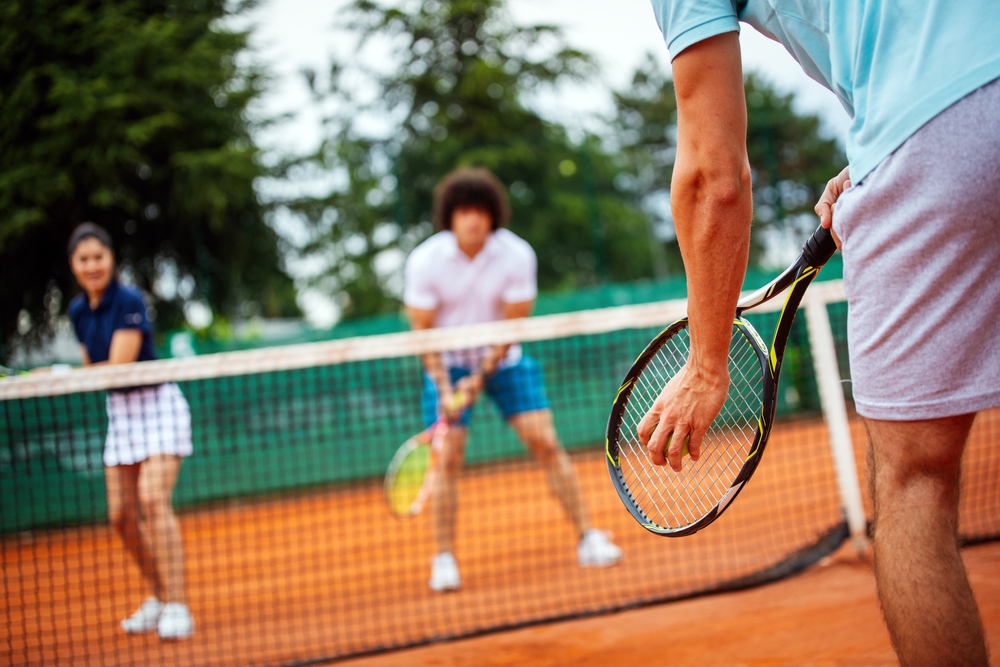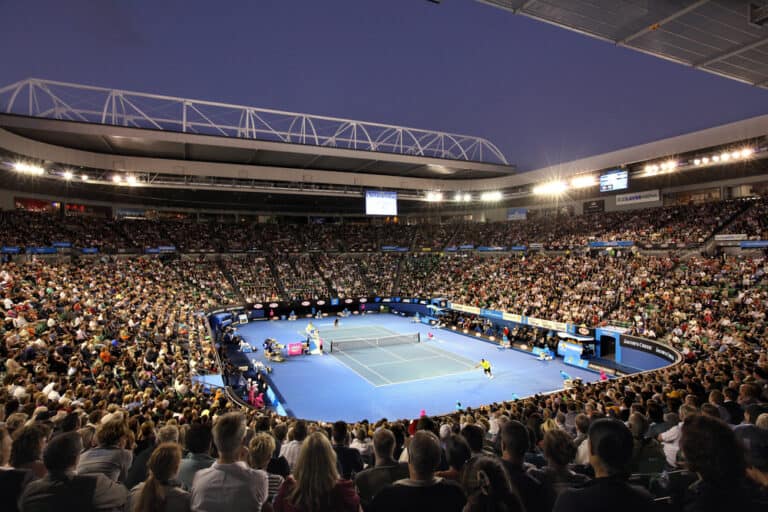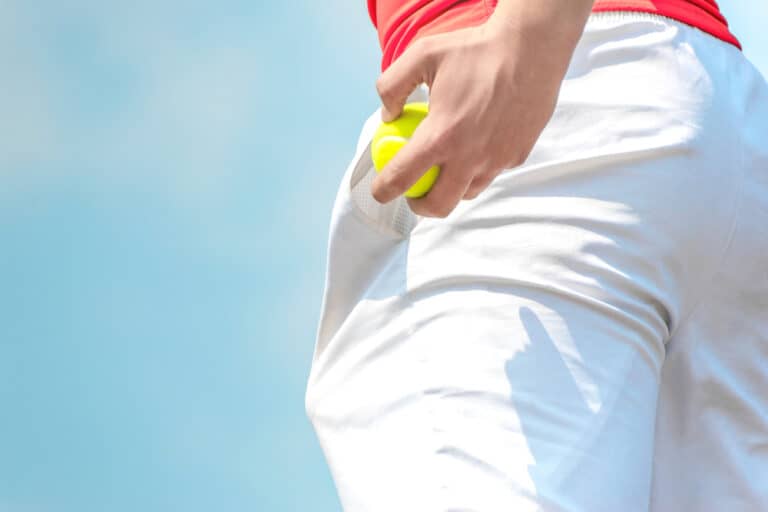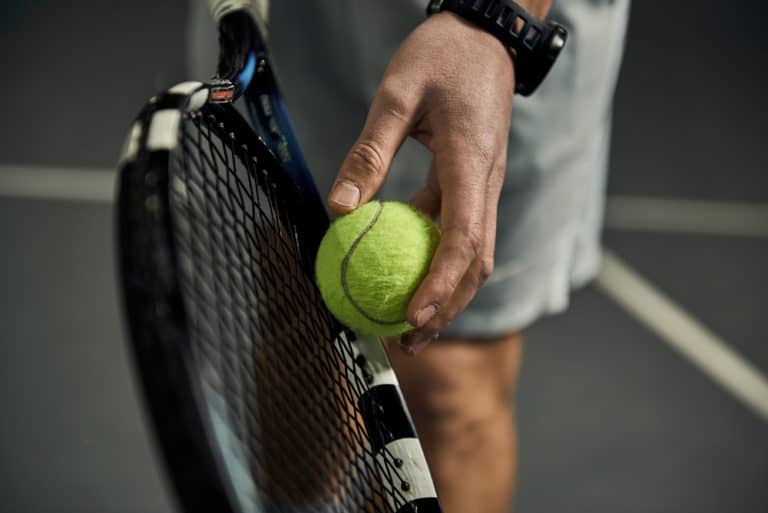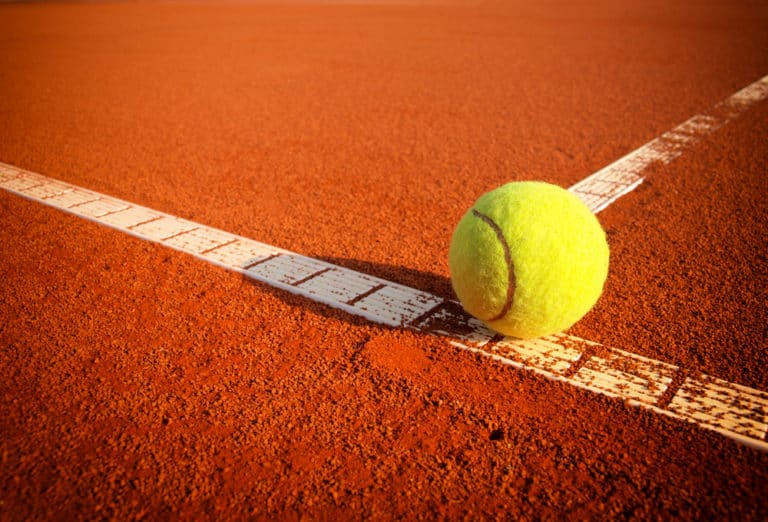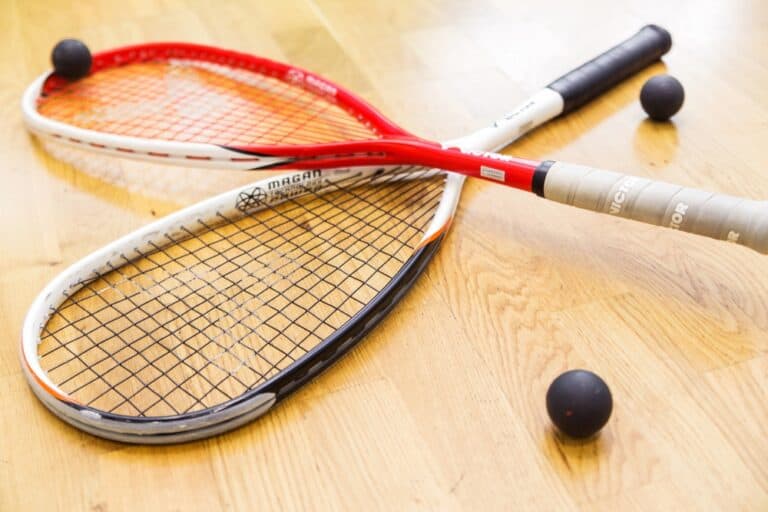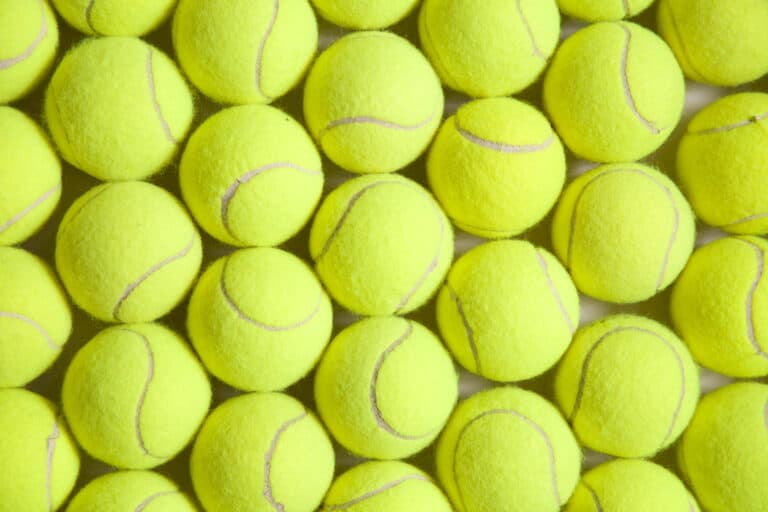Is A Double Touch Legal In Tennis?
A couple of months ago I was playing a game of doubles. I was at the net and the ball clipped my racket on the way past because I had miss-timed my shot. Even though the ball landed right in front of him, my doubles partner refused to hit the ball because of the double-touch rule. So I set about learning all that I could about the double touch in tennis and this is what I learned.
A double touch is allowed in tennis as long as the player is making one continuous swing at the ball and the ball unintentionally hits the racket twice such as strings followed by the frame. In doubles, a player is not allowed to hit a ball that has touched the racket of their partner.
Let’s take a closer look at the concept of the double touch in tennis and see all of the instances where it is permissible to use the double touch and avoid potential disagreements on the tennis court.
What Is Double Touch In Tennis?
Before we get into what is allowed or not allowed, let’s first clarify what is classified as a double touch. We’ll look at the type of double touch that can potentially happen during a game of tennis. Then we can also talk about how a player could exploit the double touch to the extreme, which will help you to understand the thought process that went into creating the rule as it was.
A double touch in tennis is defined as hitting/touching the ball twice with the racket while playing a shot. It also covers the instances where a player miss-hits the ball, takes a second swing and hits the ball a second time – or in the case of playing doubles match the first player miss-hits the ball and the partner hits the ball a second time to get it over the net.
If a double touch was legal in tennis then a player could, in theory, stop any ball using a blocking motion with their racket to pop the ball up into the air. They would then have an easy ball to hit back over the net much harder and with more control than they otherwise would. Taken even further, some players would take this to the extreme and pop the ball up high enough to play an overhead smash – or pop the ball up for their partner to smash.
As you can see, allowing double touch in these extreme cases would ruin the game of tennis as we know it. Hence, the most logical conclusion was to specifically disallow the kind of double touch in tennis which involves taking a second swing to hit the ball.
Is A Double Touch Legal In Tennis?
We need to make the distinction between a double hit and a double touch because in certain circumstances a double touch is permissible.
Looking more closely, a double hit is not allowed in tennis. In other words, a player cannot hit the ball twice in one shot, or more simply, you can’t hit the ball twice when it is your turn to hit the ball in a rally. This rule is the same across all racket sports, for instance, table tennis, squash, padel tennis, and pickleball all have a nearly identical rule.
However, the Lawn Tennis Association does add one point of clarification. According to the LTA, if in the course of a single, continuous movement of the racket, the ball comes into contact with the strings more than once, it will be allowed. By extension, if you play a shot and the ball clips the frame before hitting the strings it will be allowed. The key point here is that there is one continuous movement of the racket.
Is A Double Hit Illegal According To The USTA?
Allow me to give you an example that helps clarify the ruling as well as who gets to make the call on whether the shot was legal or not.
If your opponent plays a very hard shot at you and you play one continuous swing with your reply. If the shot is much harder than the shot you are playing it can easily feel as if the ball is staying on the racket longer or being carried on the racket in a kind of pushing motion. In this instance, your opponent might call your shot a double hit and try to claim the point.
However, as long as you didn’t make any intentional second swing or push, your shot will be legal. This is true even if the hard shot you received bounced off the strings momentarily before being hit back at your opponent. The key factor is that you made one continuous swing with your racket and didn’t make an intentional second swing at the ball after your racket hit or touched the ball on the first swing.
What’s more, the onus is on you to admit whether you made an illegal double hit by making an intentional second push with your racket after hitting the ball the first time. Your opponent cannot stop the point to claim a double hit as the rules clearly state that it is your call to make and not your opponent’s.
What Causes A Double Touch In Tennis?
The two most common types of legal double touch in tennis where the ball clips the frame of the racket either before or after impacting the strings happen more by chance than intention.
The other type of double touch where the ball impacts the racket strings twice during a single continuous swing is slightly more complex. At a basic level, a double-touch can happen when the racket head is accelerating beyond the point of impact with the ball. This acceleration means that your racket head is moving faster in your follow-through than it was when you hit the ball.
Understanding why this can happen requires a deeper look into the biomechanics of different kinds of tennis shots. Luckily for us, Wufeng Luo published a June 2022 paper, explaining this in the Hindawi Journal of Computational Intelligence and Neuroscience. In his study, he examined the difference in forehand shots between a closed stance and an open stance in right-handed tennis players.
For a right-handed tennis player, a closed stance is when your left shoulder is pointing up the court in the general direction of where you want to hit the ball, whereas an open stance is when your chest/torso is pointing up the court.
The study noted that when playing with a closed stance the ball is usually hit at the moment of the maximum velocity of the tennis racket. Conversely, when a player uses an open stance there is additional torque generated by the twisting motion of the torso when playing a forehand. This additional torque can cause the racket head to continue to accelerate beyond the point of impact resulting in a double touch of the racket onto the ball.
What Is An Illegal Shot In Tennis?
As we have already covered, double hitting of the ball with an intentional additional swing or push of the racket is illegal in tennis. However, there are 3 other types of illegal shots in tennis that you should be aware of.
Returning A Service Before The Ball Bounces
You are not permitted to play your return of service before the ball has bounced in the service block. Similarly, if the service is out/long you are not permitted to stop or catch the ball before it has bounced.
An extension of this last part of the rule applies to general play as well. A ball is called out when it bounces outside of the marked area of the court. Therefore you have to let the ball bounce in order for it to be called out. If you catch or stop the ball before it has bounced, you will lose the point.
You Cannot Throw The Racket At The Ball
If you can see that you cannot reach the ball, you are not permitted to throw your racket at the ball in the hopes that your thrown racket might hit the ball. This is a dangerous thing to do as your racket could hit your opponent or one of the line judges, a spectator, or the umpire.
However, there are instances where the racket can come out of your hand which are legal, such as a racket slipping from your hand after hitting the ball. The most common way this happens if when you play a shot near the ground and your racket frame strikes the ground as you hit the ball, pulling the racket from your grip.
In this previous example, the racket was pulled from a player’s grip in an unintentional way. There is an instance where you may deliberately throw your racket without being penalized. If you have dived to play a shot, you are permitted to toss your racket aside to avoid landing on your racket and injuring yourself.
You Cannot Strike Permanent Fixtures
You are not permitted to strike permanent fixtures with the ball. Permanent fixtures include line judges, umpires, chairs, and spectators.
However, there is an exception to this rule that applies to line judges and their chairs. If you serve an ace or player a winner that your opponent cannot reach or touch, and your otherwise legal tennis shot strikes a line judge or their chair, it stays a legal shot and you will still win the point. At the same time, if a line judge is hit by a 100 mph service they can get seriously hurt and the players will always stop to check on the line judge. Nobody wants to hurt a line judge and the first concern will be for the wellbeing of the line judge.
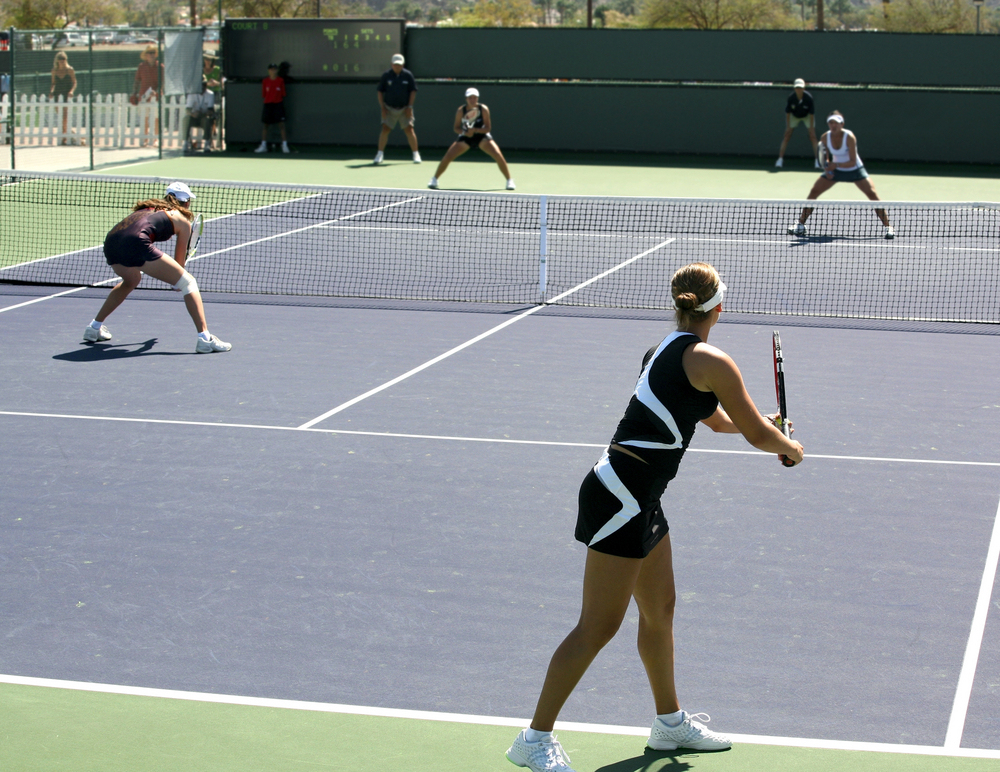
Why Can’t You Hit The Ball Twice In Tennis?
You are allowed to hit the ball twice in tennis as long as it is not intentional and done during one continuous unbroken swing. If you make a second swing at the ball or a second push at the ball after an initial swing or shot, that will be an illegal second shot and you will lose the point.
The two most common ways to legally hit the ball twice in tennis are when you swing at the ball and either the ball connects the strings, followed by the frame, or the frame followed by the strings.
In very rare instances a ball can impact the strings twice in a single shot. This happens when you swing slowly at a ball that has been hit very hard at you. When the ball impacts the strings of the racket it bounces off the strings for a fraction of a second before connecting with the strings again for the rest of the shot. In practical terms, it feels as if you are pushing the ball back to your opponent with your racket, and you will seldom feel the separation of the ball from the racket.
The key to all of these instances is that you are making a single swing at the ball and that the double hit is completely unintentional.
What Happens If You Double-Hit A Ball In Tennis?
If you double-hit the ball in tennis with a second, deliberate, swing then that will be an illegal shot and you will lose the point. An example of this kind of illegal shot will be when you stop/block the ball with your racket and then take a second swing to hit the ball.
Conversely, if you only take a single swing at the ball and the ball happens to connect with the racket during that single swing then that will be a legal shot. Should the ball clear the net and land within the marked boundaries of the court, the rally will continue as normal.
The rules also state that the onus is on you to make the call if you connected the ball twice with two different swings or with one continuous swing. Your opponent cannot claim the point from a double touch.
Can My Partner Hit The Ball After I Hit It In Tennis?
When playing doubles in tennis, each team gets one shot to return the ball to their opponents. In other words, your partner cannot hit the ball after you have hit the ball. Tennis is not live volleyball where you can set the ball up for your opponent to smash.
If you swing at the ball and the ball hits your racket twice during that single, continuous, swing it will be a legal shot. Another type of completely legal shot that I sometimes see when novices play doubles is where one player swings at the ball and completely misses. In that instance, if the partner can get to the ball and hit it the point will continue as normal.
By way of example, I can share what happened to me the most recent time I played a game of doubles. I was at the net and my partner was at the baseline. Our opponents played a lob over my head. I jumped into the air and attempted to play a smash but the ball was slightly too high for me to smash. Unfortunately for me, I somehow managed to clip the ball with the tip of my racket as it went over my head.
Even though my partner had run to my side of the court, he could not hit the ball as I had already touched it with my racket. If the ball had gone over the tip of my racket without touching it, my partner would have been able to hit the ball and the point would have continued.
Again, in this situation, it was my partner and not the opponents who made the double-touch/double-hit call and elected not to hit the ball because it had touched my racket. In the same way that the onus would be on me to make the call if I played an illegal double hit in a singles match, the onus falls on our team when playing doubles. Our opponents are not permitted to make that call.

